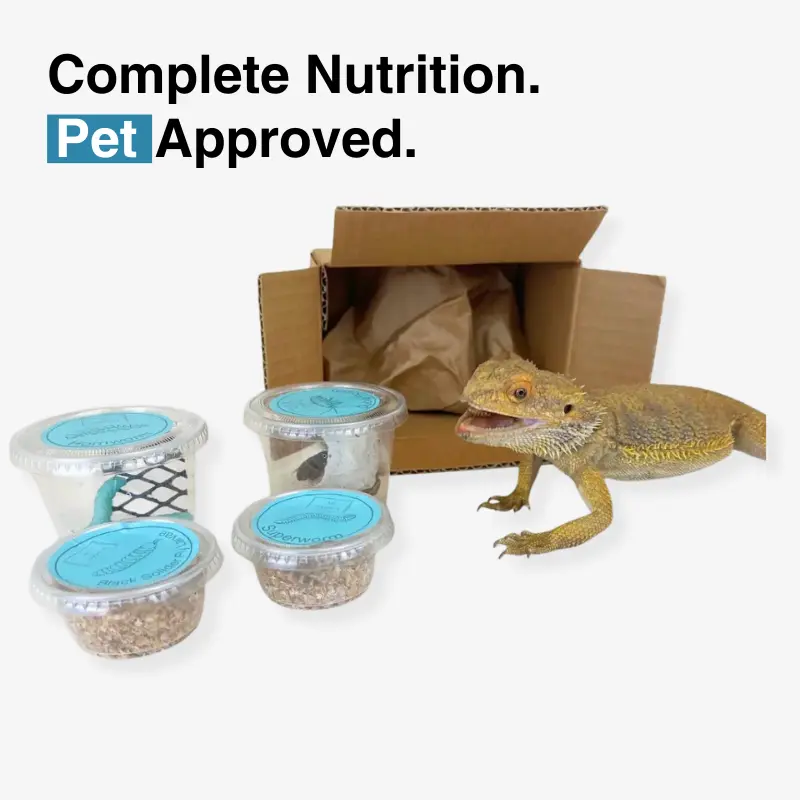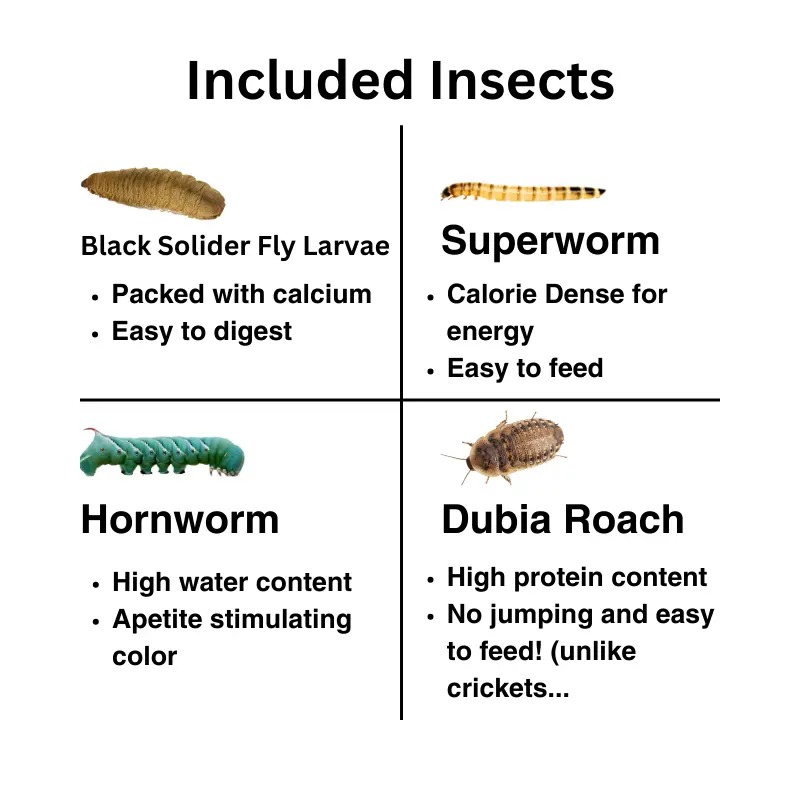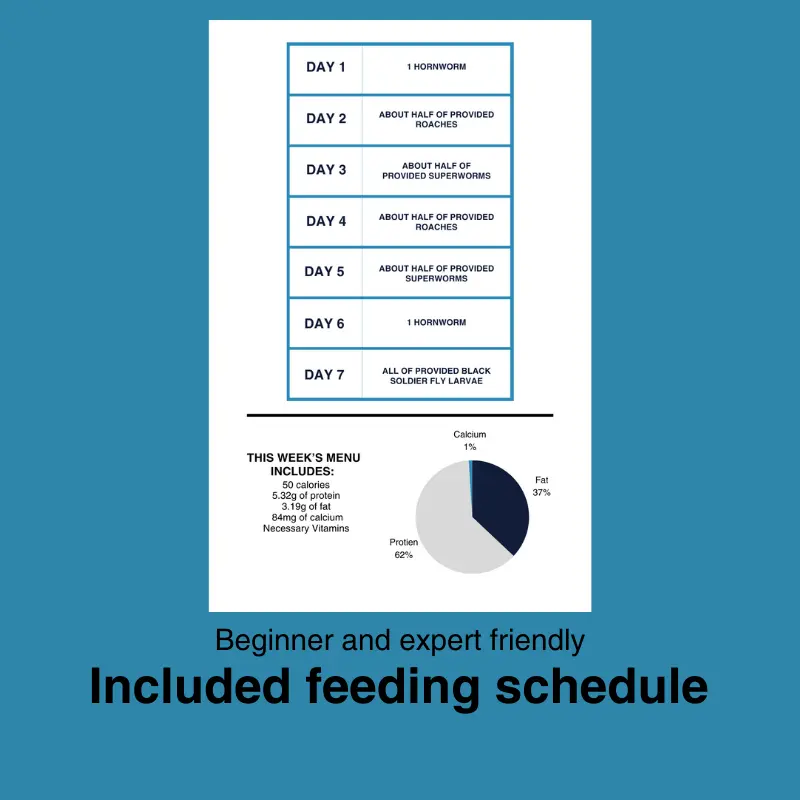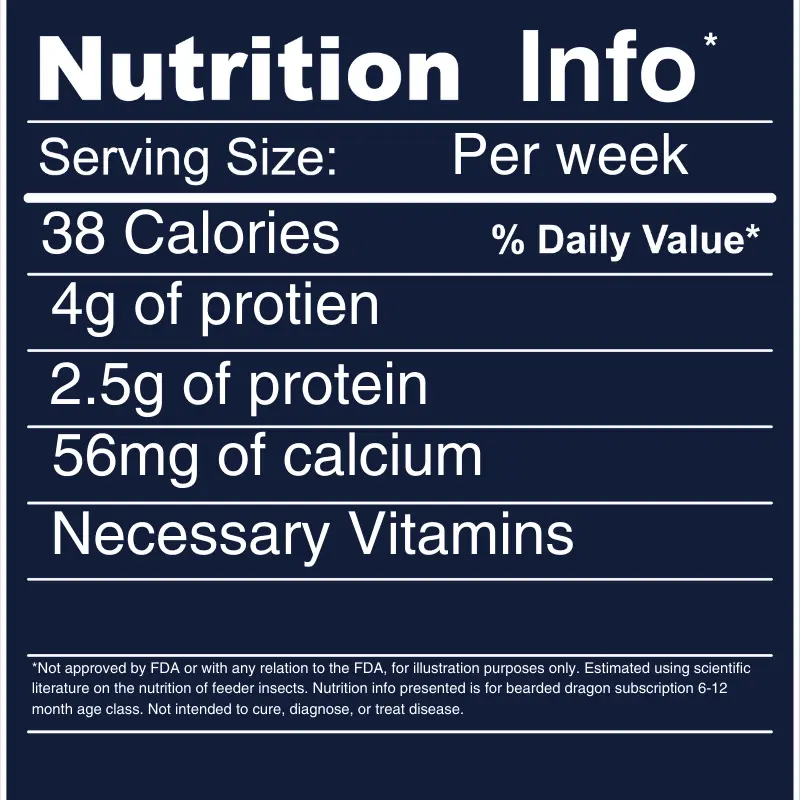Bearded Dragon Food Subscription
Responsible Pet Care Starts Here.
Flat Rate Shipping
High Quality Insects
Predictable Expense
Provided quantities are carefully selected by age. You’ll receive 4 insect types: Dubia Roaches, Hornworms, Superworms, and Black Soldier Fly Larvae.
If things don’t make it to you in great shape, no worries. We’ll take care of it.
We’ve done careful research to establish the right feeding quantity based on your pets age. We use a high-precision scale to ensure you receive exactly as much as the science says you need!
Let's Talk Diet.
The Food Your Pet Needs.
The research is clear: poor diet is a common cause of illness in captive reptiles. With ReptiBites, you can be confident you’re feeding your pet the diet they need to thrive.
Packed with Nutrients.
Diversity is critical when it comes to proper diet. Every feeder insect contains very different nutritional content. Experts agree, by feeding a variety of insects you can cover all your pet’s nutritional needs.
Up to...
Key Nutrients
Variety
Key Vitamins
of a single insect diet
Structured. Simple.
Take the guesswork out of feeding. All subscriptions include a recommended feeding schedule to keep you on track. It’s built utilizing the latest research. Proper nutrition just got way easier.
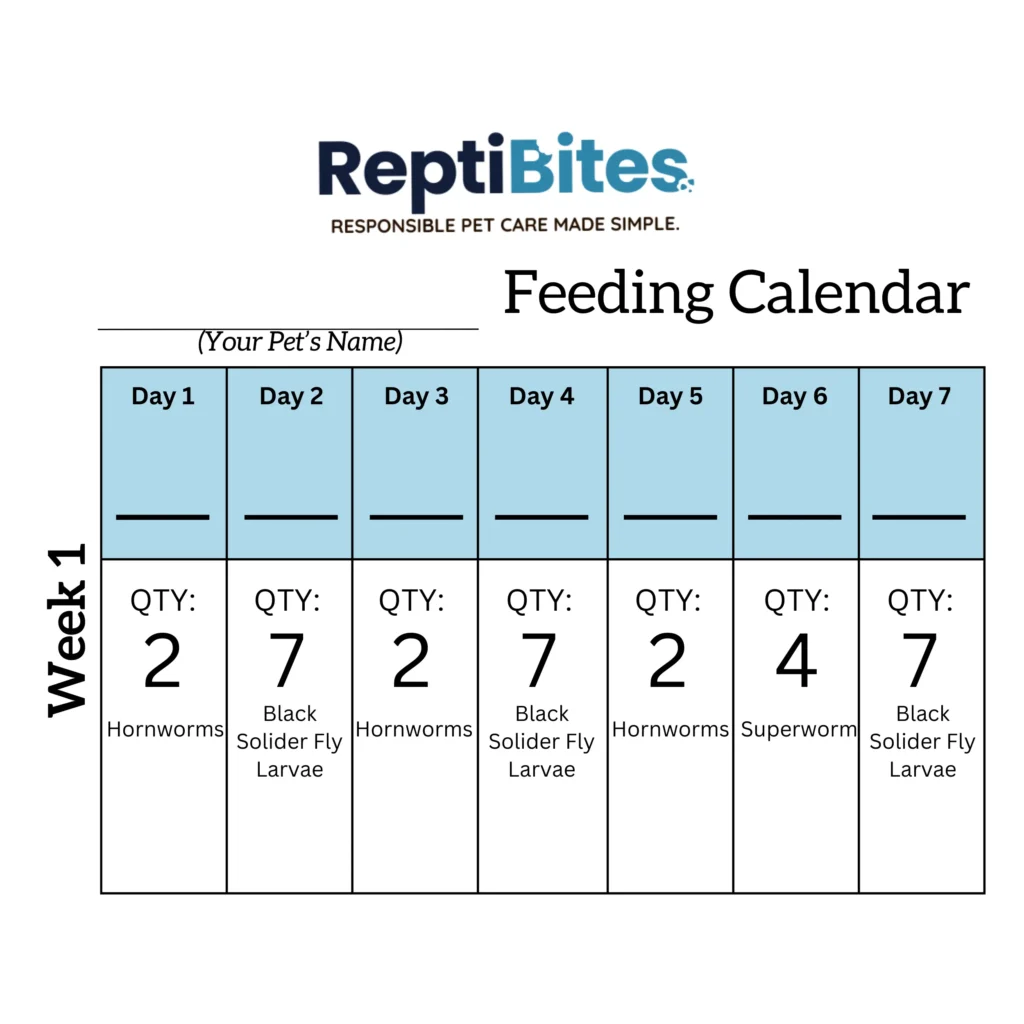
How ReptiBites was built
Decades of research
In one small box.
ReptiBites is the product of interdisciplinary research across various scientific fields, all in an effort to help you feed your pet the diet they actually need. Let’s talk about how ReptiBites was designed, and what we learned along the way.

Benefits of better diet
Let’s say you’ve been feeding your pet crickets for the past year. Why should you consider changing to a better diet? We think the answer is clear. It’s the easiest way to keep your pet happy and healthy for a long time to come. Let’s break down the true benefits.
At the end of your pet’s life, you’d do anything to buy just 15 more minutes. The good news is you can get a lot longer than that. Properly fed pets will live much longer, and are at a far lower risk of life-threatening illnesses compared to those that eat a poor diet. It’s just like humans.
Benefits Supported
Longer Life
More Time With Your Pet
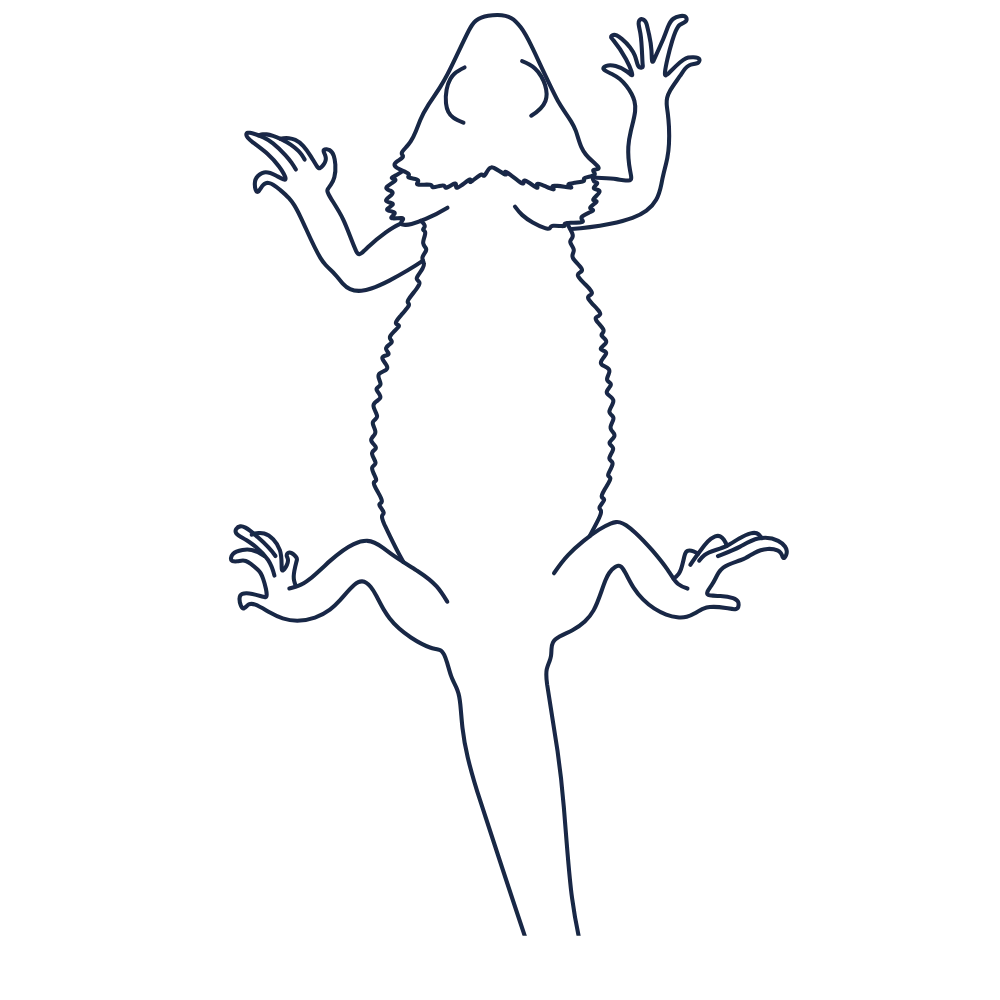
At the heart of your pet’s well-being is a strong, steady beat. The heart is a nutrient-sensitive organ. A proper diet helps maintain your pet’s health by providing essential nutrients like calcium, fatty acids, and vitamins.
Benefits Supported
Cardiovascular Support

A proper diet delivers a balanced blend of proteins, complex carbohydrates, and essential vitamins that boost energy levels and overall stamina. An active, energetic pet not only thrives physically but also provides a more engaging experience for you as an owner.
Benefits Supported
Healthy Metabolism
Your Experience

Prevent the heartbreak of premature loss. A nutrient-rich diet shields your pet from avoidable illnesses, ensuring vibrant health and longevity. By investing in quality nutrition, you eliminate the guilt associated with neglect, preserving a lifetime of joyful companionship and well-being.
Benefits Supported
Your Experience

Investing in proper nutrition today pays off tomorrow. A balanced diet not only boosts your pet’s vitality but also prevents costly health issues, significantly reducing future vet bills and related expenses. Enjoy long-term savings and quality time with your pet.
Benefits Supported
Your Wallet

Diet diversity is king.
“By expanding the dietary offerings provided to captive reptiles, we can ensure they are exposed to a broader range of nutrients, as well as limit the likelihood of the pets developing a nutritional disease.”
Dr. Mark Mitchell - Past President of the Association of Reptilian and Amphibian Veterinarians

“This author believes that provision of a diet as varied as possible is the best approach to maintaining insectivorous reptiles.”
Dr. Ryan De Voe - Senior Veterinarian at the North Carolina Zoological Park

“The biggest mistake I see pet owners make is diet. They just do not feed enough diversity.”
Cameron Young - Wildlife Biologist and Founder of My Nature Lab

The heart of ReptiBites is diversity

Soldier Fly Larvae
Solider Fly Larvae
Promotes bone health and development
Promotes bone, muscular and neurological health
Enables proper calcium absorption

Dubia Roach
Dubia Roach
For muscle
growth and maintenance
For everyday activity and movement
Promotes bone, muscular and neurological health
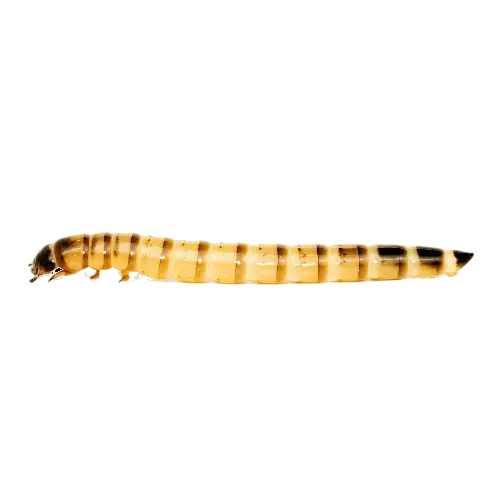
Superworm
Superworm
Promotes bone health and development
Easy to feed and enjoyed by most
Protects nerve and muscle tissue
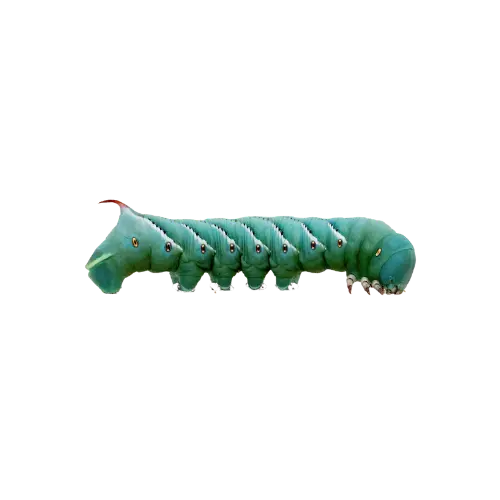
Hornworm
Hornworm
Keeps your pet hydrated
Promotes bone health and development
Easy to eat and digest
How do we compare?
Provides More Key Nutrients
Closer Match To Your Pet’s Wild Diet
Built & Delivered For You
Expert Approved
Customers (and their pets)
love ReptiBites
We’ve helped hundreds of pet owners take better care of their pets. Here’s what a few of them had to say
Excellent
Based on website customer reviews

Deborah P.
Customer Review Left on Facebook
I am so glad I ordered this .🤩 It’s a life saver and my beardie loves it. Thankful for this. Thank you for helping me to feed my Draco HEALTHIER FOOD. He loves it and so do I

Alyssa R.
Customer Review Left on Facebook
As a person who buys the beardie package they do a really good job fitting insects that fit your reptiles age. And they also send you a feeder guide on what to feed when... they go by weight so a lot of the time you get more than what they say they'll send. I think it's a very help site.

Brandy
Just wanted to update my review. They are an amazing company. Customer service is hands down one of the best my husband or I have ever dealt with. Can't thank you all enough.

Julie C.
I just got my first order, early and alive! Little beardo seems happy and I just wanted to thank you.
FAQs
What's Included?
Your insect deliveries will contain a custom-curated quantity of 4+ insect species. We design your subscription around your pet’s species and age to give them the perfect nutritional make-up they need to be healthy.
How often will I receive deliveries?
You’ll receive a delivery once every two weeks. This way, the insects you get are always fresh, and you’ll never have to worry about caring for them. We ship all insects with food to keep them healthy until your pet is ready for them.
How much is shipping?
We charge a flat rate of $4.99 for shipping. We know everyone likes free, but this way we can make sure your package arrives in an estimated 1-3 working days.
What happens if my insects don't make it alive?
The satisfaction of reptile owners and their pets is our number one priority. If you have any issues with your shipment at all, simply contact support@reptibites.com or visit our support page and we will do our best to make things right. That’s the ReptiBites Guarantee.
Do you send extra bugs, and what can I do with extras?
We always send extra bugs. Shipping live insects can be unpredictable. This way you’re covered in the case of minor insect death. This also gives you the flexibility to make adjustments to your pet’s feeding schedule as you see fit. If you find you have way too many extras, you can feed them to another pet, dispose of them by placing them in the freezer for a day, or delay your next delivery by a couple of days: free bugs!
How do I know the provided feeding schedule is accurate?
There’s really three parts to our feeding schedules:
- Feeding Frequency: Generally, younger and smaller animals need to eat more often. We match the feeding frequency of our schedules to the wild feeding behavior of your pet’s species.
- Feeding Quantity: We leverage a scientific and mathematical approach called metabolic rate. This approach accurately estimates the energy your pet requires based on their age, weight, and species, and how much food they need to meet that need. The schedules in our subscriptions are designed for the typical animal toward the middle of your subscription’s age range. If your pet is younger or older, you may consider making minor adjustments. See our section on ‘making adjustments’.
- Diet Diversity: Over the two-week schedule, we seek to maximize the diversity of your pet’s diet while also accounting for the ‘shelf-life’ of each insect type.
If you want to read more about the actual research that went into your feeding schedule, visit “The Science Behind ReptiBites” by finding the link above.
Do I need to make adjustments to the included feeding schedule? How do I do that?
Every animal is different. While our subscriptions provide a much better starting point than most recommendations, it’s still a good idea to make slight adjustments to your provided feeding schedule. Here are some reasons you might want to consider making adjustments:
- Your pet is toward the younger or older range of your subscription age class.
- Your pet is naturally smaller or larger than other individuals of their age.
- Your pet is very active or very inactive.
- Your pet needs some help with weight management.
Before making adjustments, first consider your reasons for making the change. Don’t trust your pet’s appetite alone. Almost all pets will seem hungry and ‘beg’ for more food—it’s just in their nature!
General Recommendations:
If you think your pet needs a little less food, feed 1-4 fewer insects each feeding, or skip 1-2 feedings per week. If you think your pet needs a little more food, feed 1-4 more insects each feeding.
If your pet is moderately active and not over or underweight, the calculator below does an excellent job of providing a base recommendation. Keep in mind that this recommendation is intended to maintain your dragon’s body mass. If your animal needs help with weight management, it will not provide an accurate estimate, and you will need to adjust it further. Interestingly, the calculator is still fairly accurate for growing animals of a healthy body weight.
Recommended Workflow to Dial In Your Animal’s Diet:
- Weigh your animal and use the recorded weight in combination with the calculator to assess if our standard feeding schedule needs any adjustments.
- Assess your animal’s current body condition and determine if further adjustments are needed:
- If at a healthy weight and body condition, very minor adjustments should be needed.
- If at a suboptimal body condition, follow the above recommendations as a starting point to adjust the calculator’s suggested feeding amount.
- Record and track your animal’s weight weekly, along with visual inspections of their body condition.
- Continue to fine-tune and make adjustments as needed.
The good news is that by using a more science-based approach, you are already much more likely to have a nearly perfect feeding schedule. With some attention to detail, you can customize it to give your pet exactly what they need.
Bearded Dragons: Making Adjustments
Bearded Dragon Feeding Calculator
Results
Below is an estimate of the number of insects needed to meet your dragon’s insect calorie requirement per feeding—if you were to rely on just one type of feeder. This is only an illustration; adjustments might be needed based on your animal’s activity level.
| Insect Type | Exact Quantity per Feeding | Total Insect Weight (g) |
|---|
The first and most important part of making adjustments is considering your bearded dragon’s current age and body condition. You can also consider your pet’s setup and activity level. Our feeding schedules are designed to feed a properly housed and active pet. If your pet is kept in a smaller-than-recommended enclosure, or is otherwise not very active, our feeding schedule likely recommends too much food. The best way to determine this is by assessing their body condition weekly and making small adjustments to their feeding schedule as required.
For animals on the lower end of your subscription’s age range, we recommend decreasing the number of insects per feeding by 1-2 for superworms and Dubia Roaches, and by 5-7 for BSFL.
For animals on the higher end of your subscription’s age range, we recommend increasing the number of insects per feeding by 1-2 for superworms and Dubia Roaches, and by 5 for BSFL. It’s important to be cautious whenever increasing your feeding quantity. Keep a close eye on your animal’s body condition and adjust accordingly.
The chart below describes various body conditions. Give your dragon a close look and determine where they fall. If their weight needs adjustment, refer to the top section for recommendations. Keep a close eye on things and continue to make adjustments until their body condition improves.
For sub-adult and adult animals, body condition will become more important and sensitive as their growth slows.
If you have concerns over your pet’s body condition, or would like personalized information, we recommend you speak with a registered vet.

Leopard Gecko: Making Adjustments
Leopard Gecko Feeding Calculator
Results
Below is an estimate of the number of insects needed to meet your gecko’s insect calorie requirement per feeding—if you were to rely on just one type of feeder. This is only an illustration; adjustments might be needed based on your gecko’s activity level.
| Insect Type | Exact Quantity per Feeding | Total Insect Weight (g) |
|---|
The first and most important part of making adjustments is considering your leopard gecko’s current age, and body condition. You can also consider your pet’s set up and activity level. Our feeding schedules are designed to feed a properly housed and active pet. If your pet is kept in a smaller than recommend enclosure, or is otherwise not very active, our feeding schedule likely recommends too much food. The best way to determine this is by assessing their body condition weekly, and making small adjustments to their feeding schedule as required.
For animals on the lower end of the your subscriptions age range, we recommend decreasing the number of insects per feeding by 1-2 for superworms and Dubia Roaches and by 2-3 for BSFL.
For animals on the higher end of your subscriptions age range, we recommend increasing the number of insects per feeding by 1-2 for superworms and Dubia Roaches and by 2-3 for BSFL. It’s important to be cautious whenever increasing your feeding quantity. Keep a close eye on your animals body condition and adjust accordingly.
The below chart describes various body conditions. Give your gecko a close look and determine where they fall. If their weight needs adjustment, refer to the above section for recommendation. Keep a close eye on things and continue to make adjustments until their body condition improves.
For sub-adult and adult animals, body condition will become more important and sensitive as their growth slows.
If you have concerns over your pet’s body condition, or would like personalized information, we recommend you speak with a registered vet.
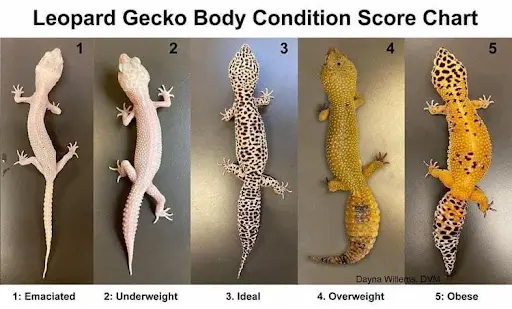
Do I need to do anything special to care for the bugs after I get them?
Typically you won’t need to do anything too special. Keep them in a cool dark place. If you notice your Superworms/Dubia Roaches have run out of their water source (carrots), it’s not a bad idea to throw some small vegetable chunks into their containers as a moisture source.
Both the Hornworms and Solider Fly Larvae have shorter shelf lives in warm temps, so do your best to keep them cool but the fridge is too cold for them! If your hornworms arrive too small, they will grow into the right size within a couple of days when kept at warmer temps (around 80F).
Keep your hornworm container upside down, on a ventilated surface. This way the feces fall away from their food source. It’s key to ensure the container can still breathe. Clean the container every couple of days by opening it above a trash can to remove the feces build up.
*based on data collected from ReptiBites subscribers. This is not properly structured science and should be considered appropriately. ReptiBites makes no guarantees concerning the health of your pet. We simply offer an easy way to feed a great diet. You’re responsible for ensuring general pet health.


